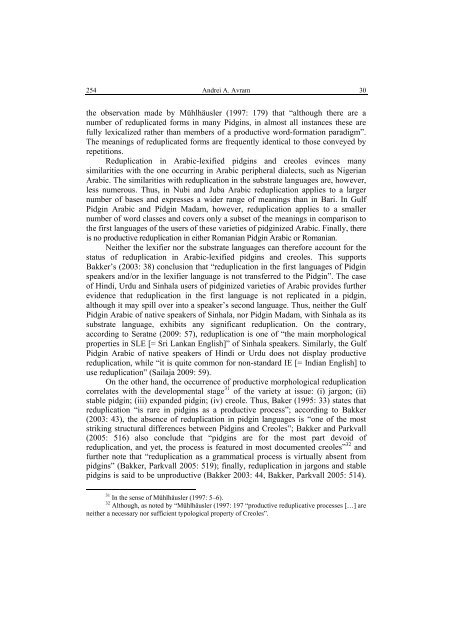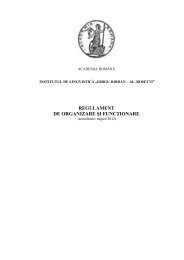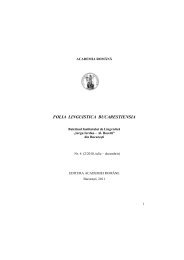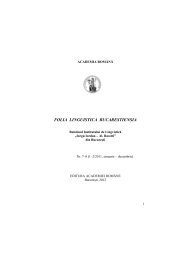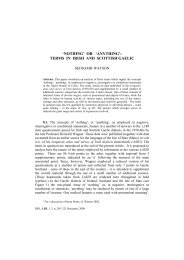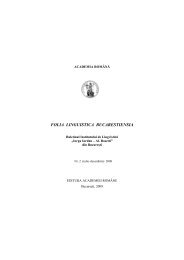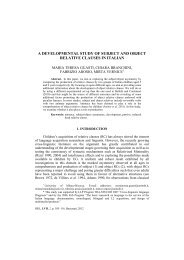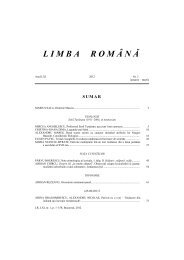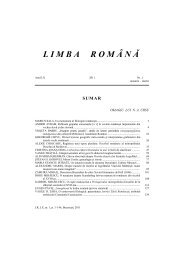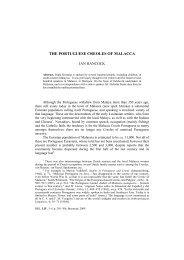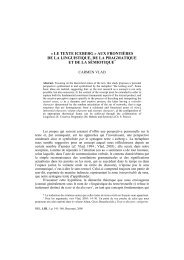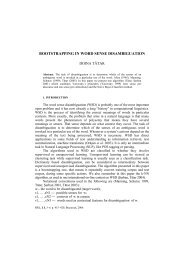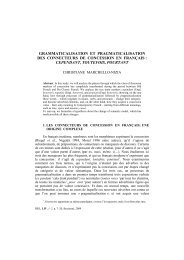254Andrei A. Avram 30the observation made by Mühlhäusler (1997: 179) that “although there are anumber of reduplicated forms in many Pidgins, in almost all instances these arefully lexicalized rather than members of a productive word-formation paradigm”.The meanings of reduplicated forms are frequently identical to those conveyed byrepetitions.Reduplication in Arabic-lexified pidgins and creoles evinces manysimilarities with the one occurring in Arabic peripheral dialects, such as NigerianArabic. The similarities with reduplication in the substrate languages are, however,less numerous. Thus, in Nubi and Juba Arabic reduplication applies to a largernumber of bases and expresses a wider range of meanings than in Bari. In GulfPidgin Arabic and Pidgin Madam, however, reduplication applies to a smallernumber of word classes and covers only a subset of the meanings in comparison tothe first languages of the users of these varieties of pidginized Arabic. Finally, thereis no productive reduplication in either Romanian Pidgin Arabic or Romanian.Neither the lexifier nor the substrate languages can therefore account for thestatus of reduplication in Arabic-lexified pidgins and creoles. This supportsBakker’s (2003: 38) conclusion that “reduplication in the first languages of Pidginspeakers and/or in the lexifier language is not transferred to the Pidgin”. The caseof Hindi, Urdu and Sinhala users of pidginized varieties of Arabic provides furtherevidence that reduplication in the first language is not replicated in a pidgin,although it may spill over into a speaker’s second language. Thus, neither the GulfPidgin Arabic of native speakers of Sinhala, nor Pidgin Madam, with Sinhala as itssubstrate language, exhibits any significant reduplication. On the contrary,according to Seratne (2009: 57), reduplication is one of “the main morphologicalproperties in SLE [= Sri Lankan English]” of Sinhala speakers. Similarly, the GulfPidgin Arabic of native speakers of Hindi or Urdu does not display productivereduplication, while “it is quite common for non-standard IE [= Indian English] touse reduplication” (Sailaja 2009: 59).On the other hand, the occurrence of productive morphological reduplicationcorrelates with the developmental stage 31 of the variety at issue: (i) jargon; (ii)stable pidgin; (iii) expanded pidgin; (iv) creole. Thus, Baker (1995: 33) states thatreduplication “is rare in pidgins as a productive process”; according to Bakker(2003: 43), the absence of reduplication in pidgin languages is “one of the moststriking structural differences between Pidgins and Creoles”; Bakker and Parkvall(2005: 516) also conclude that “pidgins are for the most part devoid ofreduplication, and yet, the process is featured in most documented creoles” 32 andfurther note that “reduplication as a grammatical process is virtually absent frompidgins” (Bakker, Parkvall 2005: 519); finally, reduplication in jargons and stablepidgins is said to be unproductive (Bakker 2003: 44, Bakker, Parkvall 2005: 514).31 In the sense of Mühlhäusler (1997: 5–6).32 Although, as noted by “Mühlhäusler (1997: 197 “productive reduplicative processes […] areneither a necessary nor sufficient typological property of Creoles”.
31 Pseudo-Reduplication, Reduplication and Repetition 255These claims are confirmed by the status of reduplication in Arabic-lexifiedpidgins and creoles. Thus, reduplication is not productive in Pidgin Madam andRomanian Pidgin Arabic – which are jargons, in Gulf Pidgin Arabic – whichappears to be undergoing stabilization 33 , and in Turku – believed to have been astable pidgin 34 . The only varieties which display (some) productive reduplicationare Juba Arabic – an expanded pidgin, but also a creole – and Nubi – a creole, i.e.precisely those in the higher developmental stages.REFERENCESAgnihotri, R. K., 2007, Hindi. An Essential Grammar, London and New York, Routledge.Anghelescu, N., 2004, La langue arabe dans une perspective typologique, Bucharest, EdituraUniversităţii din Bucureşti.Aspillera, P. S., 1989, Basic Tagalog for Foreigners and Non-Tagalogs,Tokyo, Charles E. Tuttle.Avram, A. A., 1997, “Un jargon arab”, Studii şi cercetări lingvistice, XLVIII, 1-4, 27-38.Avram, A. A., 2003, “Arabic pidgins and creoles from a comparative perspective”, Romano-Arabica,III, 25-40.Avram, A. A., 2007, “Romanian Pidgin Arabic”, Proceedings of the International Colloquium onPeripheral Arabic Dialects, Romano-Arabica, VI-VII, 13-27.Avram, A. A., 2010, “An outline of Romanian Pidgin Arabic”, Journal of Language Contact, 3, 19-37.Bakir, M. J., 2010, “Notes on the verbal system of Gulf Pidgin Arabic”, Journal of Pidgin and CreoleLanguages, 25, 2, 201-228.Bakker, P., 1995, “Pidgins”, in: J. Arends, P. Muysken and N. Smith (eds), Pidgins and Creoles. AnIntroduction, Amsterdam / Philadelphia, John Benjamins, 25-39.Bakker, P., 2003, “The absence of reduplication in pidgins”, in: S. Kouwenberg (ed.), Twice asMeaningful. Reduplication in Pidgins, Creoles and Other Contact Languages, London,Battlebridge, 37-46.Bakker, P. and Parkvall, M., 2005, “Reduplication in Pidgins and Creoles”, in: B. Hurch (ed.), Studiesin Reduplication, Berlin · New York, Mouton de Gruyter, 511-532.Bizri, F., 2005, “Le Pidgin Madam un nouveau pidgin arabe”, La linguistique, 41, 2, 54-66.Bizri, F., 2009, “Sinhala in contact with Arabic: The birth of a new pidgin in the Middle East”, in: R.Singh (ed.), Annual Review of South Asian Languages and Linguistics, 135-148.Bizri, F., 2010, Pidgin Madame. Une grammaire de la servitude, Paris, Geuthner.Booij, G., 2005, The Grammar of Words. An Introduction to Linguistic Morphology, Oxford, OxfordUniversity Press.David, B., 2000, Javanisch. Wort für Wort, Bielefeld, Reise Know-How Verlag.Haspelmath, M., 2002, Understanding Morphology, London, Arnold.Hurch, B., Kajitani, M., Mattes, V., Stangel, U. and Vollmann, R., 2008, Other reduplicationphenomena, .Kane, E., 2001, Echo Words in Tamil, PhD dissertation, Oxford University.Khamis, C. and Owens, J., 2007, “Nubi (Creole Arabic)”, in: J. Holm and P. L. Patrick (eds.),Comparative Creole Syntax. Parallel Outlines of 18 Creole Grammars, London, BattlebridgePublications, 199-216.Khan, S. D., 2006, Similarity Avoidance in Bengali Fixed-Segment Reduplication, MA dissertation,University of California, Los Angeles.33 See Næss (2008: 94), Bakir (2010: 226).34 Miller (2002: 26–27).
- Page 1 and 2: PSEUDO-REDUPLICATION, REDUPLICATION
- Page 3 and 4: 3 Pseudo-Reduplication, Reduplicati
- Page 5 and 6: 5 Pseudo-Reduplication, Reduplicati
- Page 7 and 8: 7 Pseudo-Reduplication, Reduplicati
- Page 9 and 10: 9 Pseudo-Reduplication, Reduplicati
- Page 11 and 12: 11 Pseudo-Reduplication, Reduplicat
- Page 13 and 14: 13 Pseudo-Reduplication, Reduplicat
- Page 15 and 16: 15 Pseudo-Reduplication, Reduplicat
- Page 17 and 18: 17 Pseudo-Reduplication, Reduplicat
- Page 19 and 20: 19 Pseudo-Reduplication, Reduplicat
- Page 21 and 22: 21 Pseudo-Reduplication, Reduplicat
- Page 23 and 24: 23 Pseudo-Reduplication, Reduplicat
- Page 25 and 26: 25 Pseudo-Reduplication, Reduplicat
- Page 27 and 28: 27 Pseudo-Reduplication, Reduplicat
- Page 29: 29 Pseudo-Reduplication, Reduplicat


